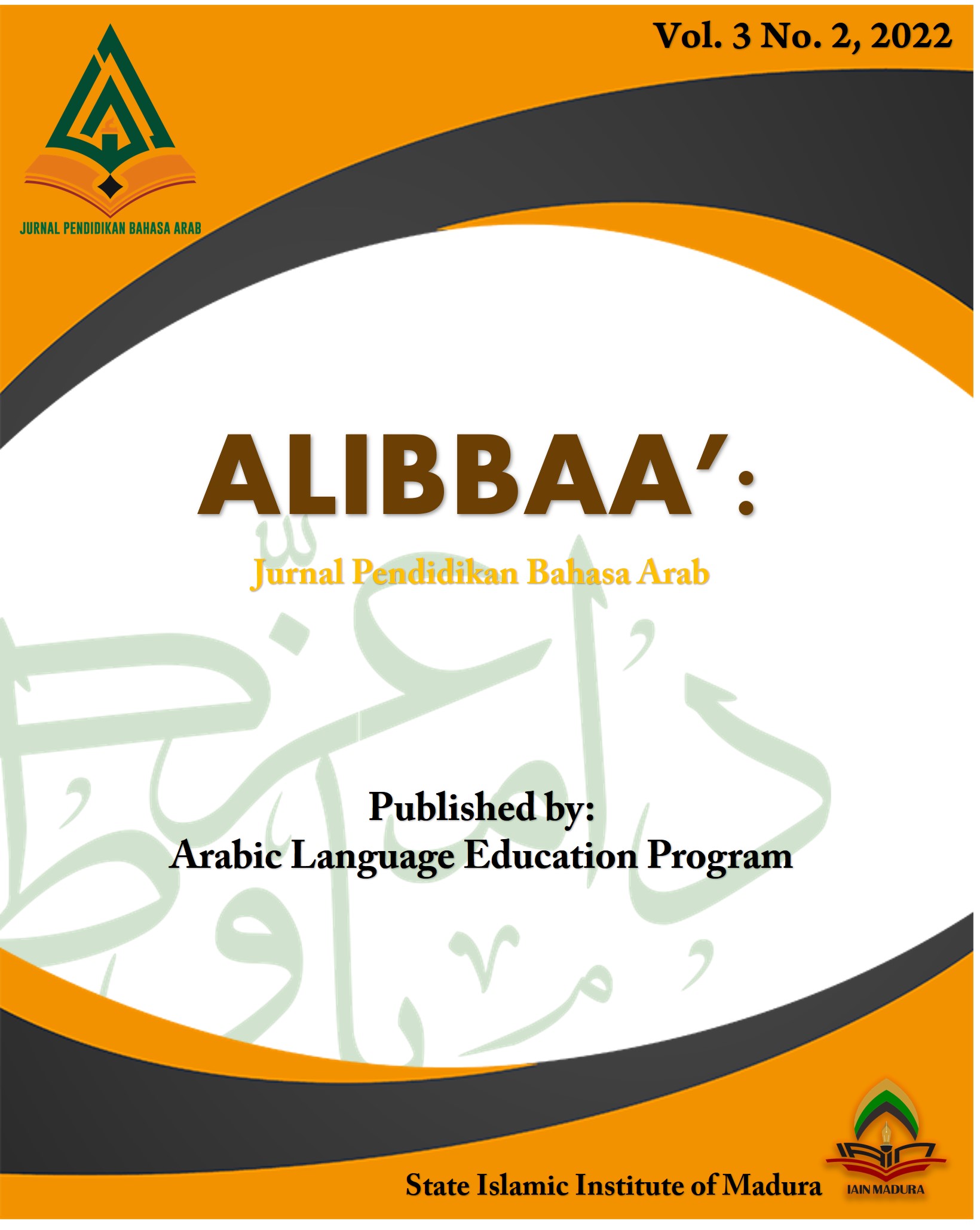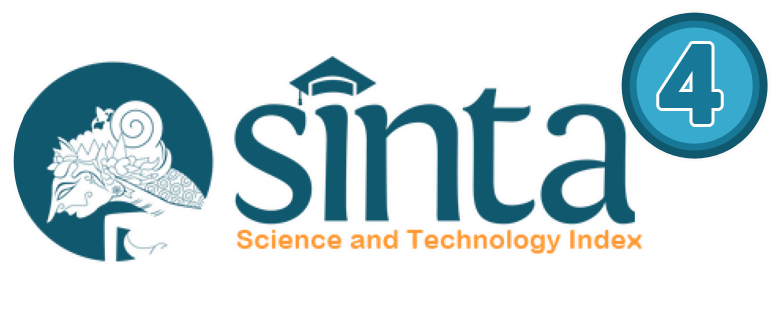Konsep Pengembangan Bahan Ajar Bahasa Arab bagi Peserta didik di Indonesia
 Abstract views: 1389
,
Abstract views: 1389
,
 pdf downloads: 2809
pdf downloads: 2809
Abstract
Several researchers have carried out studies on the development of Arabic teaching materials before this. Unlike the previous ones, this research intends to describe the product of Arabic teaching materials for non-Arabic students in Indonesia. The focus of the study includes the principles, principles, and models of developing Arabic teaching materials. The research method is library research, namely by collecting data from source books, journals, and documents that are considered appropriate to the focus of this research analysis. The results of the study indicate that several principles need to be considered in the development of teaching materials, namely cultural and social principles, psychological principles, and linguistic and educational principles. Some of the principles in the development of Arabic teaching materials are scientific, paying attention to the development and needs of students, systematic, relevance or suitability, consistency, adequacy or adequacy, actual and contextual, flexible and comprehensive. The teaching material development model itself may refer to the following models: the Ismail Shinniy et al. model, the Chatibul Umam et al. model, the al-Fauzan model, and the Abdulah Hamid model..
Downloads
References
Abdul Halim Hanafi, dkk, Desain Pembelajaran Bahasa Arab, (Jakarta: Diadit Media Press, 2013)
Abdullah Sungkat, “Problematika Linguistik dalam Pembelajaran Maharah Qiro’ah Pada Semester Vi/C Jurusan Pendidikan Bahasa Arab UIN Raden Intan Lampung 2019”, Arabia: Jurnal Pendidikan Bahasa Arab, Vol. 11 No. 1, 2019: 134-153. http://dx.doi.org/10.21043/arabia.v11i1.5001.
Al-Gali , Abdullah dan Abdul Hamid Abdullah, Menyusun Buku Ajar Bahasa Arab, (Padang: @kademia, 2012.
Al-Naqah, Mahmud, al-Kitabu al-Asasiy Li Ta’limi al-Lughah al-‘Arabiyah Li Nathiqiina Bi Lughati Ukhra: I’idadihi-Tahlilihi-Taqwimihi, (Makkah al-Mukarramah: Jami’ah Ummul Qura,1403 H.
Anam, Khoirul, and Slamet Mulyani. “Al-Musyakalah and its Urgency in Understanding the Verses of the Qur’an.” Nun: Journal of Arabic Studies 1, no. 1 2021. https://ejournal.kampusmelayu.ac.id/index.php/nun/article/view/251.
Arsanti, Meilan “Pengembangan Bahan Ajar Mata Kuliah Penulisan Kreatif Bermuatan Nilai-Nilai Pendidikan Karakter Religius Bagi Mahasiswa Prodi Pbsi, Fkip, Unissula”, Jurnal Kredo, Vol. 1 No. 2: 69-88. https://doi.org/10.24176/kredo.v1i2.2107.
Arsyad, Azhar, Bahasa Arab dan Metode Pengajarannya. Yogyakarta: Pustaka Pelajar, 2010.
Aziz, Abdul bin Ibrahim Ashily, Asasiyat Ta’lim Lughah Arabiyah Li Nathiqina bi Lughati Ukhra, Makkah Almukaaramah: Ummul Qura Universty, 1423 h.
Belawati,Tian, et.al, Pengembangan Bahan Ajar, Jakarta: Pusat Penerbitan UT, 2003.
Cholid, “Model NURS sebagai Alternatif Pembelajaran Keterampilan Membaca Bahasa Arab”, Takuana: Jurnal Pendidikan, Sains, dan Humaniora Vol. 01 No. 1: 26-39. https://doi.org/10.56113/takuana.v1i1.30.
Departemen Pendidikan Nasional, Undang-undang Sistem Pendidikan, Jakarta: Depdikbud, 2005.
Hamid, Abdul dan Nashir Abdullah al-Ghaliy, Usus I’idad al-Kitab al-Ta’limiyah Li Ghairi al-Nathiqiina Bi Ha, Riyadh: Dar al-Ghaliy
Hamid, Abdul dan Nashir Abdullah al-Ghaliy, Usus I’idad al-Kitab al-Ta’limiyah Li Ghairi al-Nathiqiina Bi Ha. Riyadh: Dar al-Ghaliy, 1991
Hamid, Abdul dan Nashr Abdullah al-Ghali, Usus I'dad al-Kutub al-Ta'limiah lighairi al-Nathiqiina bi ha, Riyadh : Dar al-Ghali, 1991.
Hamid, M. Abdul dkk, "Pengembangan Bahan Ajar Bahasa Arab Berbasis Teori Belajar Konstruktivisme Untuk peserta didik". Jurnal IMLA: Vol 4, No 1, 2019: 100. https://doi.org/10.24865/ajas.v4i1.107.
Iqbaluddin, Dicky dan Aufia Aisa, “Asas Pengembangan Bahan Ajar Bahasa Arab (Sosial Budaya, Psikologis, Kebahasaan dan Pendidikan)”, El-Wasatiya: Jurnal Studi Agama,Vo 8, No 1, 2020: 99-112. http://ejournal.kopertais4.or.id/mataraman/index.php/washatiya/article/view/3933.
Khoiriyah, Hidayatul. “Metode Qirā’ah Dalam Pembelajaran Keterampilan Reseptif Berbahasa Arab Untuk Pendidikan Tingkat Menengah.” LISANUNA: Jurnal Ilmu Bahasa Arab dan Pembelajarannya 10, no. 1, 2020. http://dx.doi.org/10.22373/ls.v10i1.7804.
Mahbub Humaidi Aziz, “Pembelajaran Maharah Kalam pada Program Kursus Bahasa Arab Pondok Pesantren Darul Lughah wad Dirasatil Islamiyah”, Vol. 17 No. 1, 2020: 13-28. https://doi.org/10.20956/jna.v17i1.8630
Mohammad Sarip, Zainal Rafli, “Arabic Speaking Material Design Using Content and Language Integrated Learning (CLIL)”, International Journal Of Humanities And Cultural Studies, Vol 5. 2018: 272-286. https://www.ijhcs.com/index.php/ijhcs/article/view/3253.
Mufidah, Nuril dan Intan Izha Rohima, “Pengajaran Kosakata untuk Mahasiswa Kelas Intensif Bahasa Arab”, Uniqbu Journal of Sciences (UJJS), Vol. 1, No. 1, 2020: 1-24. https://doi.org/10.47323/ujss.v1i1.7.
Muradi, Ahmad, “Tujuan Pembelajaran bahasa asing (Arab) Indonesia”, Al-Maqoyis, Vol. 1 No. 1, 2013: 128-137. https://jurnal.uin-antasari.ac.id/index.php/maqoyis/article/view/182.
Nata, Abuddin, Pendidikan Dalam Perspektif al-Quran. Jakarta: Prenadamedia Group, 2016.
Nurdin, Syafrudin dan Adriantoni, Kurikulum dan Pembelajaran, (Jakarta: PT Raja Grafindo, 2016.
Nurhayati, Pipih, “Pengembangan Lembar Kerja Pembelajaran IPA Berbasis Al Quran untuk Siswa MI”, Al-Ibtida: Jurnal Pendidikan Guru MI, Vol. 4, No. 1, 2017: 61-74. http://dx.doi.org/10.24235/al.ibtida.snj.v4i1.1463.
Purwati, Duwi dan Suhirman, “Pengembangan Bahan Ajar Perkuliahan Apresiasi Sastra Anak Berbasis Sugesti-Imajinatif untuk Mengoptimalkan Budaya Menulis Mahapeserta didik pada Program Studi Pendidikan Tenaga pengajar Sekolah Dasar (PGSD)”. Jurnal Ilmiah Mandala Education (JIME): Vol 3, No 1, 2017 DOI: http://dx.doi.org/10.36312/jime.v3i1.33
Sarip, Mohammad dan Zainal Rafli, “Arabic Speaking Material Design Using Content and Language Integrated Learning (CLIL)”, International Journal Of Humanities And Cultural Studies, Vol 5. 2018: 272-286. https://www.ijhcs.com/index.php/ijhcs/article/view/3253.
Satriadi, Muassomah, “Cooperative Learning Dalam Bahasa Arab: Metode Belajar di MA Nurul Huda”, Alibbaa’: Jurnal Pendidikan Bahasa Arab, Vol. 2 No. 2, 2021: 161-174. https://doi.org/10.19105/ajpba.v2i2.4798.
Sumantri, Budi Agus, and Nurul Ahmad. “Teori Belajar Humanistik Dan Implikasinya Terhadap Pembelajaran Pendidikan Agama Islam.” FONDATIA Vol. 3, No. 2, 2019: 1-18. https://doi.org/10.36088/fondatia.v3i2.216.
Syaifullah, Muhammad dan Nailul Izzah, "Kajian Teoritis Pengembangan Bahan Ajar Bahasa Arab,” Arabiyatuna: Jurnal Bahasa Arab, Vol. 3 No. 1, 2019: 127. http://dx.doi.org/10.29240/jba.v3i1.764.
Thu’aimah, Rusydi Ahmad, Dalil Fi I’idad al-Mawad al-Ta’limiyah Li Baramij Ta’lim Al-‘Arabiyah, Makkah al-Mukarramah, Dar al-Marikh, 1985.
Tolinggi, Syindi Oktaviani R., “Pembelajaran Bahasa Arab di Indonesia pada Era Revolusi Teknologi Tak Terbatas,” AN NABIGHAH, Vol. 23, No.1, 2021: 33-50. https://doi.org/10.32332/an-nabighoh.v23i1.2231.
Walgito, Bimo, Pengantar Psikologi Umum, Yogyakarta: Penerbit Andi, 2004.
Yunus,Fathi, Ta’lim al-Lughah al-A’rabiyah, Kairo: Dar Al-Nahdhah, 1984.
Zainuri, Muhammad “Perkembangan Bahasa Arab di Indonesia”, Jurnal Tarling, Vol. 2, No.2, 2019: 231-248. https://doi.org/10.24090/tarling.v2i2.2926.
Zaki, Mohammad, “Urgensi Bahan Ajar Bahasa Arab sebagai Penentu Dalam Proses Belajar Mengajar”, Al-Af’idah, Vol. 5 No.1, 2021: 92-104. https://doi.org/https://doi.org/10.52266/al-afidah.v5i1.876.
Authors who publish with this journal agree to the following terms:
a. Authors retain copyright and grant the journal right of first publication with the work simultaneously licensed under a Creative Commons Attribution License that allows others to share the work with an acknowledgement of the work's authorship and initial publication in this journal.
b. Authors are able to enter into separate, additional contractual arrangements for the non-exclusive distribution of the journal's published version of the work (e.g., post it to an institutional repository or publish it in a book), with an acknowledgement of its initial publication in this journal.
c. Authors are permitted and encouraged to post their work online (e.g., in institutional repositories or on their website) prior to and during the submission process, as it can lead to productive exchanges, as well as earlier and greater citation of published work (See The Effect of Open Access).
Alibbaa': Jurnal Pendidikan Bahasa Arab have CC-BY-SA or an equivalent license as the optimal license for the publication, distribution, use, and reuse of scholarly work.
In developing strategy and setting priorities, Alibbaa': Jurnal Pendidikan Bahasa Arab recognize that free access is better than priced access, libre access is better than free access, and libre under CC-BY-SA or the equivalent is better than libre under more restrictive open licenses. We should achieve what we can when we can. We should not delay achieving free in order to achieve libre, and we should not stop with free when we can achieve libre.

Alibbaa': Jurnal Pendidikan Bahasa Arab is licensed under a Creative Commons Attribution 4.0 International License
You are free to:
- Share — copy and redistribute the material in any medium or format
- Adapt — remix, transform, and build upon the material for any purpose, even commercially.
- The licensor cannot revoke these freedoms as long as you follow the license terms.











